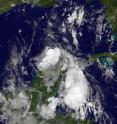GOES-13 satellite movie shows formation of Tropical Storm Don
Tropical Storm Don formed at 5 p.m. EDT last night, July 27, in the southern Gulf of Mexico and appears to be a small storm on GOES-13 satellite imagery. NASA compiled two days of GOES-13 imagery in a 30 second movie that shows how and where Don formed. GOES-13, the Geostationary Operational Environmental Satellite, watched on July 27, as the low pressure area called System 90L strengthened quickly into tropical depression number 4, and then tropical storm Don. Data from the NOAA managed GOES-13 satellite was processed at NASA's GOES Project at the NASA Goddard Space Flight Center, Greenbelt, Md. and made into an animation that showed Don's quick birth.
The 30 second movie of Don's birth in the southern Gulf of Mexico runs from July 26 at 1315 UTC (9:15 a.m. EDT) to July 28 at 1045 UTC (6:45 a.m. EDT). GOES-13 imagery shows Don to be around 100 miles in diameter, and tropical storm-force winds extend 45 miles from Don's center.
As of July 28, a tropical storm watch is in effect for Texas coast from the mouth of the Rio Grande northward to west of San Luis Pass and those conditions are possible by late Friday.
At 5 a.m. EDT on July 28, Don had maximum sustained winds near 40 mph (65 kmh). It was located about 495 miles (795 east-southeast) of Brownsville, Texas near 23.0 North and 88.7 West. Don's estimated minimum central pressure is 1000 millibars. Don is moving toward the west-northwest near 10 mph (17 kmh) and is expected to continue on this track through Friday, according to the National Hurricane Center. Don is also expected to speed up.
The Brownsville, Texas National Weather Service office posted the tropical storm watch and forecasts "isolated to scattered showers and some thunderstorms and tropical storm force winds will accompany Don as it eventually makes landfall in south or deep South Texas."
Source: NASA/Goddard Space Flight Center
Articles on the same topic
- Tropical Storm Muifa appears huge on NASA infrared imageryFri, 29 Jul 2011, 20:35:18 UTC
- Tropical Storm Don analyzed in 3 NASA satellite imagesFri, 29 Jul 2011, 20:35:07 UTC
- NASA identifies the areas of Tropical Storm Muifa's strength Thu, 28 Jul 2011, 19:14:57 UTC
- NASA eyes Tropical Storm Nock-Ten's heavy rains for Hainan Island and VietnamThu, 28 Jul 2011, 19:14:49 UTC
- Tropical Depression 11W moving past Yap and GuamWed, 27 Jul 2011, 18:36:23 UTC
- NASA measures heavy rain in Tropical Storm Nock-Ten over PhilippinesWed, 27 Jul 2011, 18:36:13 UTC
- NASA sees Tropical Storm Nock-ten knocking the PhilippinesWed, 27 Jul 2011, 15:05:46 UTC
- NASA sees dramatic temperatures around Tropical Depression 11WWed, 27 Jul 2011, 15:05:35 UTC
- Tropical Depression 10W bringing rain to the PhilippinesWed, 27 Jul 2011, 15:05:23 UTC
Other sources
- Tropical Storm Don analyzed in 3 NASA satellite imagesfrom PhysorgSat, 30 Jul 2011, 8:30:30 UTC
- NASA identifies the areas of Tropical Storm Muifa's strengthfrom PhysorgThu, 28 Jul 2011, 19:10:42 UTC
- GOES-13 satellite movie shows formation of Tropical Storm Donfrom PhysorgThu, 28 Jul 2011, 15:30:45 UTC
- NASA sees Tropical Storm Nock-ten knocking the Philippinesfrom PhysorgWed, 27 Jul 2011, 15:02:23 UTC
- NASA sees dramatic temperatures around Tropical Depression 11Wfrom PhysorgWed, 27 Jul 2011, 15:02:18 UTC
- Tropical Depression 10W bringing rain to the Philippinesfrom PhysorgMon, 25 Jul 2011, 21:00:40 UTC
